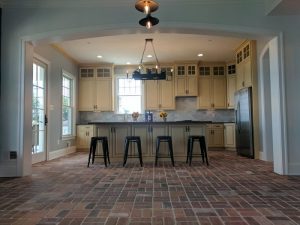
Have you ever considered brick flooring for your custom home? Here’s more on this unique material!
The modern kitchen floor can be any material you want it to be. One can draw from the latest trends, such as polished concrete or bold tile, or go back to historical materials such as slate and other natural stones. One option that few might think about is brick. Brick flooring for kitchens is beautiful and practical for the modern custom home. Below are the pros and cons of this unique flooring material.
Pros
Patterns
Just like with outdoor applications, brick flooring for the kitchen, hallway, living room, etc., can be arranged in many different classic and custom patterns. Herringbone, basketweave, running bond, and Flemish bond are just a few.
Colors
Brick flooring doesn’t have to be one shade of red or orange. Different treatments of the brick will produce uniform or varied tones and different shades. A burning treatment can create a variation of black and reddish hues, while whitewashing can give the brick a white-sprinkled or opaque look.
Durability
Brick homes last generations, and so can brick flooring for kitchens. Brick is a natural material made of clay and can clearly stand the test of time, as seen in many historic homes. It is also fireproof, so dropping a match on the floor by accident will create soot but won’t ultimately hurt the clay.
Historicity
Brick is beautiful and historical. It has a warm, inviting look and texture and is used as flooring in many historic mansions in multiple countries, including the United States and France. Brick flooring could work great in either a colonial-style or modern-style home.
Cons
Sealing
All flooring requires maintenance, but some materials need more upkeep than others. Brick is a porous material and may need sealing every 6-12 months to keep it safe from water and other liquids. On the Maryland waterfront, this is especially important. You could also wax the brick, but this will reduce its traction.
Hardness
If you install brick flooring in your custom waterfront home, you might want to add a few padded rugs underfoot. Brick is hard and can be difficult to stand on for long periods, such as while preparing a big meal. Nevertheless, it keeps its temperature in winter, so your feet won’t freeze!
BUILD YOUR WATERFRONT DREAM HOME WITH SHORE-LINE CONSTRUCTION!
At Shore-Line Construction, we know that your home is a reflection of you. That’s why we strive to make each home we build as beautiful as the family who will live there. We work with each of our clients to design a home that fits their needs. The end result is a durable, energy-efficient custom home that the family will enjoy for generations to come. Shore-Line Construction has been serving our customers for over 25 years, and we look forward to the opportunity to help you!
If you’re interested in learning more about what Shore-Line Construction can do for you, check out our website or give us a call at 410-574-6623. Keep up with all of the latest news by following our blog and social media pages on Facebook, YouTube, Pinterest, and Houzz!



